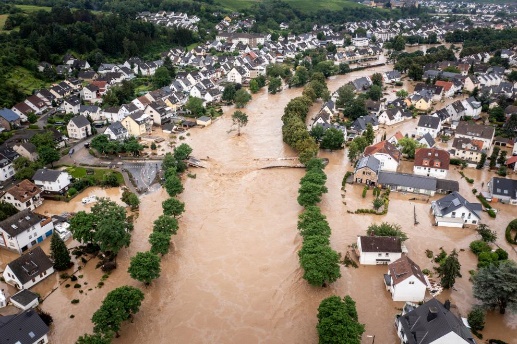
Disclaimer: Copyright infringement not intended.
Context
- Heavy rains have hit France, England, Netherlands and Germany for more than two weeks, causing rivers to burst their banks in many areas, flooding homes and prompting evacuations.
Reasons behind the Rise in Flooding in European Countries
Climate Change-Induced Extreme Weather:
- Changes in global climate patterns have led to more frequent and intense rainfall events, increasing the risk of flooding.
- Example: The devastating floods in Germany and Belgium in July 2021 were linked to unprecedented levels of rainfall, with some areas receiving several months' worth of rain in just a few days.
Urbanization and Altered Land Use:
- Rapid urbanization and changes in land use contribute to increased surface runoff, reducing natural water absorption.
- Example: The expansion of urban areas in the Paris metropolitan region has led to increased impervious surfaces, exacerbating flooding during heavy rainfall events.
River and Coastal Flooding:
- Changes in precipitation patterns and rising sea levels intensify river and coastal flooding.
- Example: The Netherlands, with a significant portion of its land below sea level, faces increased risks of river and coastal flooding due to sea-level rise and extreme weather events.
Inadequate Infrastructure and Aging Drainage Systems:
- Aging infrastructure and inadequate drainage systems contribute to the vulnerability of regions to flooding.
- Example: Venice, Italy, experiences recurrent flooding, aggravated by the outdated design of the city's drainage and pumping systems.
Deforestation and Land Degradation:
- Deforestation and land degradation reduce the natural capacity of ecosystems to absorb and regulate water flow.
- Example: The extensive deforestation in parts of central and eastern Europe has increased the risk of flash floods and soil erosion.
Increased River Channelization:
- Alterations to river channels and excessive channelization reduce natural floodplains, exacerbating flood risks.
- Example: The channelization of the Loire River in France has altered its natural course, contributing to increased flood risks downstream.
Poor Water Management Practices:
- Inefficient water management practices, including inadequate reservoir management, can lead to uncontrolled water releases during heavy rainfall.
- Example: The mismanagement of reservoirs in the Elbe River basin in Germany during the 2013 floods worsened downstream flooding in affected regions.
Melting Glaciers and Snowmelt:
- The melting of glaciers and increased snowmelt contribute to elevated river levels and increased flood risks.
- Example: The Alps, a major source of rivers in Europe, have experienced accelerated glacier melt, influencing river discharge patterns and contributing to flooding events.
Changes in Atmospheric Circulation:
- Alterations in atmospheric circulation patterns can result in prolonged periods of heavy rainfall and increased flooding.
- Example: Changes in the North Atlantic Oscillation (NAO) have been linked to shifts in weather patterns, influencing precipitation levels and contributing to flooding events in Europe.
Land Use Planning and Zoning Issues:
- Poor land use planning and zoning regulations can lead to construction in flood-prone areas, increasing vulnerability.
- Example: The 2014 flooding in the Balkans was exacerbated by inadequate land use planning, allowing construction in flood-prone regions.
- Addressing the rise in flooding requires a holistic approach, encompassing climate resilience, sustainable land use practices, improved infrastructure, and effective water management strategies.

Implications
The rise in flooding in European countries carries significant implications across various sectors, impacting communities, economies, and the environment. Here are the key implications:
Human Lives and Safety:
- Implication: Increased flooding poses a direct threat to human lives, leading to casualties and injuries during extreme weather events.
- Example: The 2002 flooding in Central Europe resulted in numerous fatalities, emphasizing the immediate danger flooding poses to residents.
Property and Infrastructure Damage:
- Implication: Flooding causes extensive damage to homes, businesses, and critical infrastructure, leading to substantial economic losses.
- Example: The 2013 floods in Germany resulted in billions of euros in damages, affecting residential areas, transportation networks, and industrial facilities.
Economic Disruption:
- Implication: Flood-related damages disrupt economic activities, affecting industries, agriculture, and trade.
- Example: The disruption of transportation and production during the 2019 Venice floods impacted the local economy, particularly the tourism sector.
Displacement and Migration:
- Implication: Communities living in flood-prone areas may face displacement, leading to internal or cross-border migration.
- Example: Flood-induced displacement in low-lying regions of the Netherlands may necessitate migration to safer areas.
Environmental Impact:
- Implication: Flooding has environmental consequences, including soil erosion, loss of biodiversity, and contamination of water bodies.
- Example: The flooding of the Elbe River in 2002 resulted in soil erosion and the spread of pollutants, impacting ecosystems and aquatic life.
Infrastructure Strain:
- Implication: Frequent flooding strains existing infrastructure, including drainage systems, levees, and flood defenses.
- Example: The strain on the Thames Barrier in London during increased flooding events underscores the need for continuous maintenance and upgrades.
Health Risks:
- Implication: Flooding can lead to health risks, including waterborne diseases, as contaminated water may pose a threat to public health.
- Example: Post-flood outbreaks of waterborne diseases, such as gastroenteritis, highlight the health risks associated with contaminated floodwaters.
Insurance Costs and Financial Burden:
- Implication: Increased flooding leads to higher insurance claims and financial burdens on individuals, businesses, and governments.
- Example: Rising insurance premiums in flood-prone areas, such as those affected by the Seine River floods in Paris, reflect the increased financial risk.
Impact on Agriculture:
- Implication: Floods damage crops, disrupt agricultural activities, and contribute to food supply chain disruptions.
- Example: The 2010 floods in Pakistan submerged large agricultural areas, leading to substantial losses in crop production and livestock.
Social and Community Disruption:
- Implication: Floods disrupt community life, affecting social cohesion and placing additional stress on local resources.
- Example: The 2014 Balkans floods led to social disruption, displacing communities and straining local support systems.
Solutions and Measures
Invest in Resilient Infrastructure:
- Upgrade and maintain flood defenses, including levees and barriers, to withstand extreme weather events.
- Example: The Netherlands' Delta Works, a system of dams, sluices, locks, dikes, and levees, is a renowned example of resilient infrastructure that protects low-lying areas from flooding.
Implement Sustainable Urban Planning:
- Integrate green infrastructure, such as permeable surfaces and green roofs, into urban planning to reduce surface runoff.
- Example: Copenhagen, Denmark, incorporates sustainable urban planning practices, including green roofs and permeable pavements, to mitigate flood risks.
Enhance Early Warning Systems:
- Invest in advanced early warning systems to provide timely alerts and evacuation plans for communities at risk.
- Example: Germany's KATWARN system sends real-time alerts to residents about potential disasters, including floods, improving preparedness.
Promote Natural Flood Defenses:
- Concrete Measure: Implement nature-based solutions like reforestation and wetland restoration to enhance natural flood defenses.
- Example: The Rhineland-Palatinate region in Germany has initiated projects to restore floodplain forests, acting as a natural buffer against floods.
Integrate Climate-Resilient Agriculture:
- Concrete Measure: Promote climate-resilient agricultural practices to minimize soil erosion and runoff.
- Example: The Netherlands employs innovative agricultural practices, such as precision farming, to enhance resilience to climate-related challenges, including flooding.
Adopt Smart Water Management:
- Concrete Measure: Implement smart water management systems to monitor water levels and optimize reservoir releases.
- Example: Lyon, France, has deployed a smart water management system to monitor the Rhône River and enhance flood control measures.
Invest in Community Awareness and Training:
- Concrete Measure: Conduct public awareness campaigns and community training programs to educate residents about flood risks and preparedness measures.
- Example: The Netherlands has comprehensive community engagement programs, including flood drills and educational initiatives, to enhance public awareness and readiness.
Encourage Cross-Border Cooperation:
- Concrete Measure: Facilitate international collaboration for effective management of transboundary rivers and addressing shared flood risks.
- Example: The International Commission for the Protection of the Danube River involves collaboration among European countries to manage flood risks along the Danube.

Implement Sustainable Water Storage:
- Concrete Measure: Develop sustainable water storage solutions, such as artificial reservoirs, to regulate water flow during extreme weather events.
- Example: The Three Gorges Dam in China serves as a model for large-scale water storage, helping regulate river flow and prevent downstream flooding.
Enforce Strict Zoning Regulations:
- Concrete Measure: Enforce strict land use planning and zoning regulations to prevent construction in flood-prone areas.
- Example: The floodplain zoning regulations in Switzerland restrict construction in vulnerable areas, minimizing exposure to flood risks.
Implementing these concrete measures requires collaboration among governments, communities, and international organizations to build resilience and adapt to the changing climate, ultimately mitigating the impact of flooding in European countries.
|
PRACTICE QUESTION
Q. Examine the multifaceted challenges posed by the rise in flooding in European countries. Discuss the key contributing factors, implications across various sectors, and critically evaluate the effectiveness of existing measures in addressing this phenomenon. Provide concrete examples to support your analysis and suggest innovative strategies for sustainable flood risk mitigation in the European context."
Note: This question is designed to assess the candidate's understanding of the complex issues related to flooding in Europe, including causal factors, consequences, existing measures, and the ability to propose sustainable solutions.Top of Form
|
















